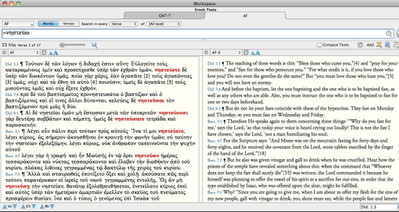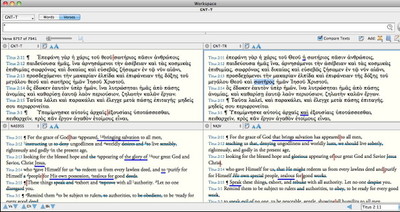
The primary reason I decided to purchase Accordance in 2005 was for the original language tools. I had been trained in seminary to use the Greek and Hebrew text, and I wanted to maximize those skills, even grow them, in pastoral ministry. I’m happy to report that Accordance has been more than up to the challenge of keeping me regularly engaged with the Greek and Hebrew text and sharpening my original language skills. Many Accordance users are familiar with the basic Greek and Hebrew texts and search commands, so for this article, I want to discuss some other aspects of Greek and Hebrew research that pastors might not regularly consider, including the use of non-biblical original language texts and textual criticism.
Non-biblical Original Language Texts
Like most of you, some of the first Accordance texts I purchased were the GNT-T and the LXX1/LXX2 modules. It didn’t take me long to realize, however, that I could greatly enhance my exegesis by looking beyond these two foundational texts. So what texts would most enhance my biblical studies and sermon preparation? As I considered this question, I began to look through BDAG to see what works were being referenced frequently.
One that immediately stood out to me was the Apostolic Fathers module. It is full of early interpretations of the biblical text (not to mention some very entertaining works, such as the Shepherd of Hermas!). For example, if I were preaching through the Sermon on the Mount and I came to Matthew 6:16-18, I might want to know more about the practice of fasting. Bible dictionaries, commentaries, and other resources certainly would help, but reading early interpretations in works like the Didache is also invaluable. For example, Jesus instructed His followers not to be like the hypocrites in their fasting. The Didache takes up this very thought in Did. 8:1, “But do not let your fasts coincide with those of the hypocrites. They fast on Monday and Thursday, so you must fast on Wednesday and Friday.” A simple word search for “to fast” (νηστεύω) reveals that the Apostolic Fathers module mentions fasting 23 times.
In addition to the Apostolic Fathers module, I often find myself referring to Josephus’ works and the Pseudepigrapha. While these kinds of modules might not immediately jump out at the busy pastor, they are the kinds of Greek texts that can not only enhance his understanding of the New Testament but sharpen his Greek skills as well. As a New Testament scholar, I primarily use extra-biblical Greek texts, but original language Semitic texts such as the Targums are a gold mine of information for Old Testament exegesis.
Textual Criticism
In the NAS95S text, Titus 2:11 reads, “For the grace of God has appeared, bringing salvation to all men,” but in the NKJV, the same verse reads, “For the grace of God that brings salvation has appeared to all men.” The difference between these two translations potentially has significant implications for understanding the Apostle Paul’s theology of the atonement. What should we make of these translations? Do they illustrate a different theological bent in the translation committees, or is something else at play?
One of the quickest ways to find out is to view the base text of each translation side by side with Accordance’s Compare Texts feature enabled and set to Single Text. The NAS95S is based on the NA27 Greek text (GNT-T), while the NKJV is based on the Textus Receptus (GNT-TR). Take a look at the workspace below:
With the compare texts feature enabled, we can immediately spot a textual difficulty in Titus 2:11. The TR includes an article before the word σωτήριος (“bringing salvation”), while the NA27 omits the article. This difference has grammatical significance. In the NASB/NA27, the adjective σωτήριος is understood as a predicate adjective describing what the grace of God has done in appearing. However, with the article before it, the NKJV/TR takes σωτήριος as an attributive adjective modifying what the grace of God is like. It is the “salvation-bringing” grace of God.
What is the pastor to do in this kind of situation? Undoubtedly, he has his text-critical work cut out for him. The good news is that the pastor knows why this difference exists, and that it’s not simply a matter of translation committees having a different underlying theology.
The Compare Texts feature is often used in conjunction with English texts, but its hidden power is its ability to compare original language texts. Such comparisons enable the busy pastor to quickly spot differences in texts to see where major text-critical problems lie. With the variety of New Testament texts available in Accordance and the new Multiple Texts feature added to the Compare Texts command, pastors have unprecedented options for examining evidence for variant readings.
Next time you’re studying the biblical text and you get in an exegetical bind, I hope you find these tips helpful. Check out some other original language texts to see if they shed light on grammatical, syntactical, or lexical problems, and don’t forget to use the Compare Texts feature to see if peculiarities exist in the manuscript tradition.



